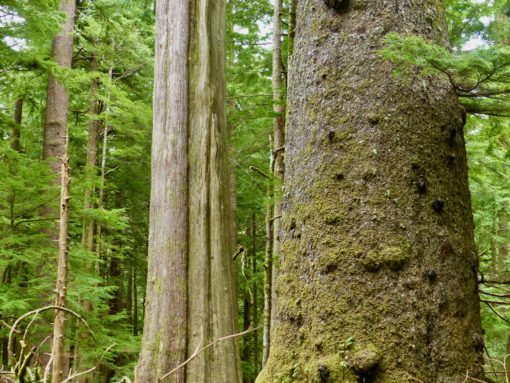
Old-growth forest, Oregon Coast Rangel. Photo: Jeffrey St. Clair.
Gifford Pinchot, first chief of the U.S. Forest Service often said: “Conservation is the foresighted utilization, preservation and/or renewal of forests, waters, lands and minerals for the greatest good of the greatest number for the longest time.” It has become the agency’s motto.
Yet in the age of climate change, the Forest Service has failed to reevaluate what exactly constitutes the greatest good for society.
One of the biggest costs to society resulting from Forest Service thinning and logging practices is the loss of carbon storage. Forests are among our best and most passive means of keeping carbon out of the atmosphere. Primary forests store 30-70% more carbon than logged forests.
Logging and thinning along with wood product production contribute to 35% of the carbon emissions in Oregon, even topping transportation which is 23%. There is nothing that we could do that would do more to reduce Oregon’s contribution to global warming than to reduce timber harvest, especially on public lands. [1]
Across the West, most carbon emissions (66%) results from logging, while wildfires contribute to about 15% of CO2 releases. [2]
Proponents of logging like to suggest that using wood products for houses stores carbon, however, only 16% of the original carbon in a harvested tree ultimately ends up in some wood product.[3] Plus, many wood products like wooden pallets, paper, and cardboard have a noticeably short shelf life. Thus, thinning and logging a forest guarantees carbon loss and release into the atmosphere.
Ironically much of the Forest Service timber program is justified in the name of precluding wildfires. Yet nearly all large wildfires are driven by drought, low humidity, high temperatures, and winds, not fuels. And all these variables are increased by climate change. Logging the forest exacerbates and contributes to the factors that drive large wildfires.
Not to mention there is plenty of evidence that logging/thinning the forest often enhances fire risk by putting more fine fuels on the forest floor, opening the canopy, and leading to greater drying of fuels, and greater wind operation.
Even though wildfires do release some carbon (about 4% of Oregon’s emissions), most of all carbon remains on site. What burns in a forest fire are the fine fuels—needles, small branches, and shrubs, not trees. That is why you have snags after a fire. The bulk of all carbon in a tree is in the bole and roots which remain after a fire and continue to store carbon. In addition, any charcoal that results from a fire is a long-term carbon storage mechanism, that can hold carbon for thousands of years.
The economic value to society of keeping carbon in the forest vastly exceeds any economic return on wood products. Unfortunately, when the Forest Service does any economic analysis it typically ignores or minimizes the non-monetary values.
Logging/thinning ravages forest ecosystems by removing dead wood debris, introducing weeds, disturbing wildlife, reducing or eliminating roadless areas, changing tree age structure, compacting soils, adding sedimentation to aquatic ecosystems, and removal of biomass (nutrients) from the site.
If we were to manage forests for their greatest economic value, we would prioritize their ability to store carbon, not to mention other positive outcomes like preserving wildlife habitat, watershed protection, and scenic values.
The Forest Service timber practices are made even more egregious because it losses money on nearly all logging projects. So, in addition to the environmental degradation to forest ecosystems mentioned above resulting from logging, we also reduce the opportunity to preserve carbon in our forests.
Given today’s realities, the greatest good for society is to leave natural forests intact.
Notes.
[1] https://www.hcn.org/issues/50.11/climate-change-timber-is-oregons-biggest-carbon-polluter
[2] Intact Forests in the United States: Proforestation Mitigates Climate Change and Serves the Greatest
Good. William R. Moomaw, Susan A. Masino and Edward K. Faison Frontiers in Forests and Global Change | www.frontiersin.org 1 June 2019 | Volume 2 | Article 27
[3] Meeting GHG reduction targets requires accounting for all forest sector emissions. (2019) Tara W Hudiburg , Beverly E Law William R Moomaw , Mark E Harmon2 and Jeffrey E Stenzel. Environ. Res. Lett. 14 (2019) 095005 https://doi.org/10.1088/1748-9326/ab28bb